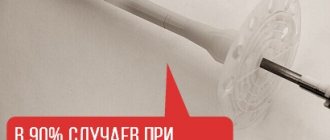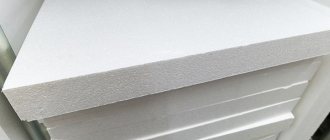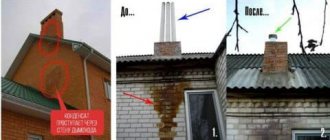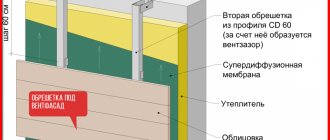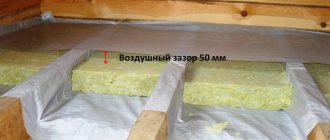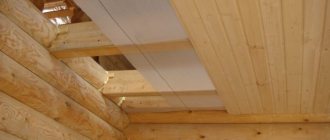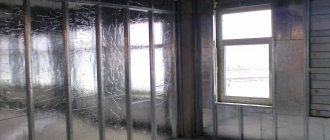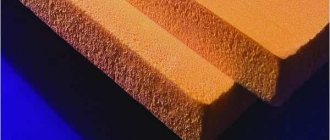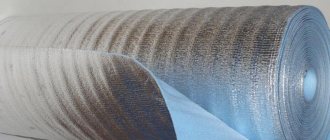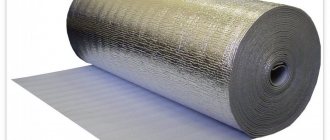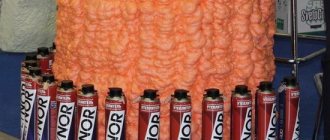Foil materials: structure and principle of operation
Even people far from construction have at least once encountered insulation that is shiny on one side; the name of one or another of its varieties is known to owners involved in construction or repair. Such materials are often called two-layer, because of the conspicuous metal (reflective) layer; There are options coated with a reflective layer on both sides.
The bottom (or inner) layer is made of a porous or fibrous material. It serves as thermal insulation and serves as a strong base for the foil. The foil component, glued on top of the insulation, is needed to reflect infrared (thermal) radiation. It is made of aluminum foil or metallized film, different in properties:
- Aluminium foil . It is applied by heat welding and polished to the desired reflectance (95%). The foil is destroyed by the salt contained in the cement mortar.
Foil retains heat in the room Source otoplenie-gid.ru
- Metallized film . Apply to one or two sides of the material. It reflects less heat, but is resistant to alkaline influences.
Each layer has its own “responsibilities”. The foil reflects thermal energy, and does it effectively: according to manufacturers, up to 90-95% of thermal radiation is returned. The remaining percentage is partially absorbed by the insulation, and partially the heat is dissipated in space.
Attention! Practical measurements have shown that the efficiency of foil thermal insulation is 30-60% higher than that of a similar single-layer thermal insulation material. It is important that the price difference is not so significant; In the long term, this means savings on heating.
Foil underfloor heating reduces heat loss Source veralline.com
Pros and cons of reflective insulation
A wide range of applications makes shiny insulation in demand; what this or that variety is called and where it is used depends on the composition of the layers. Foil-based materials are designed to protect ceilings, floors and walls; They are used to insulate pipes and roof vaults. Widespread use is possible thanks to properties, some of which are unique to them:
- High efficiency . A shiny coating allows only 5-10% of heat waves to pass through, the rest are reflected back.
- Hydro- and vapor barrier . The metallized layer is irresistible to atmospheric moisture and steam. This property is actively used in the construction of baths and saunas.
- Easy installation . The material is secured with a stapler or nails; some varieties are made on a self-adhesive basis. Insulation with foil is flexible and easy to install on complex shaped surfaces.
Forming a gap for ventilation Source world-comfort55.rf
See also: Catalog of companies that specialize in insulating houses
- Long-term operation . Achieved with proper installation. The insulation will not become moldy, and the metallized layer will not collapse.
- Safety . Reflective thermal insulation materials are non-toxic to humans.
The disadvantages include the following features:
- Thermos effect . It occurs as a result of the circular use of foil material in violation of installation rules, and provokes the appearance of mold. The problem is not always solved with ventilation.
- Terms of Use . Concrete is a bad neighbor for aluminum foil; the salts it contains corrode the metal layer within a year.
- Thermal conductivity . The heat-reflecting layer, like any metal, heats up, due to which some of the energy is lost.
Wall mounting Source pechiexpert.ru
Laying methods
Let's consider which side is the correct way to lay the insulation with foil on the floor.
Heat-saving properties depend on how correctly the insulation is installed.
Foil reflects infrared radiation, therefore, the metallized layer must be laid so that it faces the inside of the room.
Insulation of concrete floor
Place the casing with the foil side down
Most often, the rolled material is fixed to the concrete base using a special glue made on the basis of rubber.
Installation sequence:
- We prepare the surface. We level the slab so that there is no large difference in height. We seal all cracks and cracks with cement mortar.
- We spread the material on the floor with the foil layer facing up and cut it to the required length. We move the strip aside and apply glue to the place where it is laid. Let it sit for a few minutes according to the instructions for the glue. We lay and press the material well. We place the strips close to each other.
- We secure the joints with foil tape, which is sold in hardware stores.
For additional insulation of cold floors, wooden logs can be laid on top, the space between which is filled with slab insulation. Floorboards or sheet material (OSB, fiberboard, chipboard) are placed on top of it. For an interesting comparison of foil materials, watch this video:
You can secure the material with double-sided tape glued around the perimeter or dowels.
Wood floor insulation
It is most convenient to lay the material on an adhesive layer
It is most convenient to lay foil insulation on a wooden floor, which has a bottom self-adhesive layer.
If you bought material without an adhesive base, then you need to fix it with staples using a construction stapler or with double-sided tape.
Related article: How to sew curtain tape: step-by-step instructions
Laying sequence:
- We remove the baseboards, remove debris and dust using a vacuum cleaner.
- If the boards have uneven surfaces, we sand them with a special machine and, if necessary, sand them (remove the top layer of the board).
- We seal all existing cracks with wood putty.
- We prime with an antiseptic composition.
- We measure the room, cut the roll, and lay it up with foil. It can be easily cut to size using sharp sewing scissors.
- Lay out the strips end to end. We wait a day for the material to settle and straighten out. If the heat insulator has a self-adhesive base, gradually remove the protective film and press it tightly to the surface. We lay the next strip end-to-end.
- We fix the joints of the strips with foil tape.
Once the material has been laid, the selected flooring can be installed.
Foil insulation for heated floors
When laying insulation under heated floors, lay the material with the foil facing up so that it reflects heat into the room
The base for heated floors must be flat without differences in height or defects. All errors must be eliminated.
Stages of laying thermal insulation with a layer of foil:
- We lay out the foil material in strips end to end, and glue the joints with special tape.
- We install a system of electric or water heated floors on top.
- We lay hydro- and vapor barrier material. It will prevent concrete from leaking onto the floor heating elements.
- We fill the screed with a thickness of 30-50 mm, depending on the type of heating elements and the functional purpose of the room.
Warm floors can only be turned on after the screed has completely dried. This will take about a month.
Insulation under floating screed
Having bought a two-layer material, you don’t have to bother with the question of which side to lay the insulation on
It is characterized by the fact that the slab is not rigidly fastened to the concrete screed; thermal insulation is laid between them.
Installation sequence:
- We prepare the base and eliminate all defects.
- We plaster the lower part of the walls.
- We stick damper tape around the perimeter of the walls; its height should be equal to the thickness of the floor: from the slab to the floor covering.
- We prime the base in two layers. Apply the next layer after the previous one has dried.
- We lay thermal insulating foil boards with the foil facing up. We use a metallized coating that is resistant to cement mortar. We lay the slabs strictly in a horizontal plane, close to each other. Uneven laying of insulation boards contributes to the formation of cracks in the concrete solution.
- We glue the joints of the plates with tape.
- We pour the concrete screed.
Related article: Wallpaper in Provence style: photos in the interior, for the walls of the kitchen, bedroom and living room, floral, country and Provence collection, children's companions, in the hallway, video
Lightweight and durable insulation with a layer of foil is becoming increasingly popular among consumers and professional builders due to its high heat retention and ease of installation. For more information about isolation, watch this video:
We looked at how to properly lay foil material for high-quality floor insulation. Thermal insulating material is always laid with foil on the outside; if you lay it the other way around, it will not retain heat fully.
Types of reflective insulation
For owners who have started construction or renovation, it is not indifferent to the name of the insulation, on one side of which foil is glued, since not all varieties are interchangeable. It is equally important to understand how to properly install insulation with foil in order to minimize heat loss. There are several types of thermal insulators with foil on the market, with different thermal insulating material as a base.
Foamed polyethylene (polyethylene foam)
The material looks like an elastic fabric 2-10 mm thick, structurally consisting of closed-porous cells. Insulation is sold in rolls; some manufacturers supply it with a self-adhesive base; The reflective layer is aluminum foil.
Polyethylene foam with foil is suitable for thermal insulation of the floor, where it is placed under the final finish (for example, laminate). For heating radiators, thin varieties of fabric are chosen as a reflective screen. Elastic material is suitable for insulating water and sewerage pipes; it will keep the pipes from freezing and at the same time protect the owners from annoying noise.
Insulation made of foamed polyethylene Source of peace-comfort55.rf
How to lay insulation with foil for pipes
Shells for insulating communications are made of polystyrene foam and mineral wool.
In addition to thermal insulation for floors, horizontal ceilings and walls, there is also insulation with a reflective layer for pipe insulation. These are shells that are made of polystyrene foam or mineral wool. The former are lighter and are not afraid of moisture, while the latter can withstand high temperatures, which is appropriate when insulating chimney pipes. Considering the fact that the material is already produced in the form of a pipe, the question of whether to put the insulation with foil on the outside or inside is not worth it. There is a shell that you put on the pipe and that’s it, you can’t turn it inside out.
At the same time, there is always a choice when purchasing, since they are also produced with one (outer) or two (outer and inner) layers of foil. Such shells are used for:
- laying pipelines by air;
- laying highways underground;
- laying pipelines in unheated rooms;
- insulation of chimneys.
In some cases, they are used to insulate pipes so that the coolant does not lose its temperature even in heated rooms. For example, in industries where the first and last heat exchanger of one circulation ring are installed at a great distance from each other.
Features of installation of foil insulation
Before purchasing, measurements are taken and the required quantity is calculated based on the fact that the insulation will be fixed not overlapping, but end-to-end. The question of how to properly lay insulation is solved in the same way for both types of metallized coating. When insulating walls, adhere to the following rules:
- Foil thermal insulation is laid with the reflective (shiny) side inside the room.
- Double-sided material is intended for thermal insulation of frame buildings.
- Installation on walls includes the organization of sheathing, the slab insulator is fixed in it between the guides and is additionally strengthened with dowels.
- Installation on the ceiling is carried out using a stapler. The joints are sealed with metallized tape or aluminum adhesive tape. Between the insulation and the final finish, a gap of 2-2.5 cm is created for ventilation.
Fixing joints Source krovlyaikrysha.ru
Thermal insulation of various structural elements
In frame house construction, it is advisable to use reflective insulation for thermal insulation of the floor. It is better to install “breathable” mineral wool on the walls without a foil layer, otherwise air exchange into the room will be difficult. The technology for fastening materials depends on the scope of its application: inside the house, insulation of the roof, floor or pipelines.
Wall insulation with Penofol or Penoflex
The difference between the materials is the thermal insulation backing. In Penofol it is foamed polyethylene foam, and in Penoflex it is extruded polystyrene foam. The technical characteristics and methods of their installation are similar.
Useful: Tool for building a frame house
Sequence of work:
- According to the size of the purchased insulation (roll width), install a wooden frame on the walls. The slats are secured with dowels, the maximum distance is 1 m.
- Cut Penofol - cut into pieces, the length of which corresponds to the height of the room with allowances of 8-10 cm on each side.
- Apply the rolled material to the wall, straighten it and attach it to the wooden slats with a construction stapler. Penofol should not hang down or be excessively stretched.
- Place a sheathing of bars about 2 cm thick on top of the insulation. This will provide the required ventilated gap.
Such thermal insulation is perfect for walls in a country house , glassed-in balcony, utility room or building for keeping animals.
Thermal insulation of the roof with three-layer insulation
Thin roll insulation for a roof is not enough. Penofol is best used in combination with mineral wool; an alternative option is thermal insulation with foil mats made of basalt wool.
Instructions for performing work on installing insulation with two metallized layers:
- Lay waterproofing on top of the rafters horizontally. The canvases are attached with an overlap in the direction from bottom to top.
- Press the hydraulic barrier to the beams with counter-lattice strips. Next, you need to fill them with horizontal bars of the main sheathing. The roofing will be installed on top.
- Attach planks 50-60 cm thick to the rafters on the inside, installation step 60 cm.
- “Shoot” three-layer penofol to the formed frame, cover the seams with aluminum tape.
When attaching the inner lining, it is necessary to provide an air pocket. Ceilings are also insulated using a similar principle.
If Penofol is installed in pairs with additional insulation, for example, mineral wool, then one metallized layer is sufficient.
Briefly about the main thing
Reflective insulation works according to a special principle based on a layer structure. The main layer consists of a porous or fibrous material; on top (sometimes on both sides) it is complemented by a layer of aluminum foil or metallized film.
It is the shiny surface that does the main job of retaining heat in the room. Additionally, it serves as a steam, hydro and sound insulator, and if the installation technology is violated, it causes the appearance of a thermos effect.
Common foil materials include polyethylene foam, basalt and glass wool, and foil polystyrene foam. To fix the material on the surface, you need a stapler or dowels; the joints are fixed with aluminum adhesive tape.
Ratings 0
Types and their characteristics
All types of traditional insulating materials are subject to metallization. For each of them, a technology has been developed that allows the layers to be reliably connected to each other, without delamination when the temperature changes.
Insulation for heated floors Source filesonload.ru
Paper based foil
The multilayer material consists of an aluminum film (several tens of microns thick) and a backing in the form of kraft paper (sometimes mesh). Between the outer layers there is a layer of polyethylene. It glues and reinforces the outer layers, further improving water and vapor barrier characteristics.
By itself, foil on kraft paper does not have insulating properties. It is used in conjunction with traditional thermal insulation materials indoors and outdoors. Foil is used to insulate attics and attics, ceilings and floors. The material is suitable for insulating pipes, boilers, air ducts, and walls in living rooms behind heating radiators.
As an independent reflective insulation, it is needed where short-term preservation of high temperatures is important: in a bathhouse or sauna. Here its use is especially preferable. Unlike roofing felt, plastics and glassine, it does not release hazardous substances when the temperature rises.
On craft paper Source prom.st
